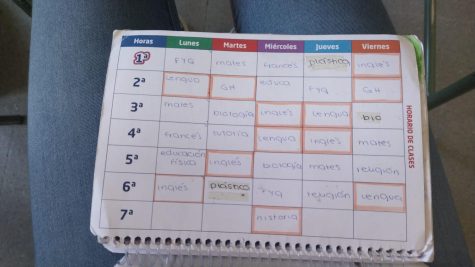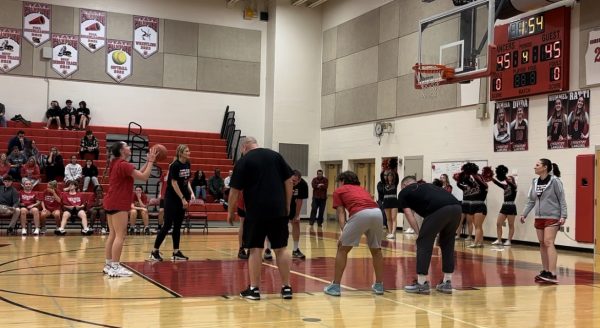American vs European schools: Which is really the best?
The picture on top shows IES Carmen Conde High School located in Madrid, Spain. The picture at the bottom shows Linganore high school located in Frederick county, Md.
June 2, 2023
Most people think that American and European schools are very similar, with many common characteristics, but this is only partially true. What most people do not know, however, is that U.S. schooling and European schooling differ in many ways, too.
Many want to know which is more effective and which do students enjoy most based on the different classes, homework and teaching styles.
First, the most noticeable difference from the building itself is the size of the school. Schools in America are generally much larger and hold more students than the schools in European countries. The classes are usually larger, as is the amount of furniture and school materials inside the rooms.
“This school is bigger than mine in Europe,” Maria Doneddu, an exchange student from Italy currently living in America and attending Linganore high school said. “They have more students here; there are over a 1000 students, and in Europe I have like 800. The classes are really big here, with more furniture, more stuff you can use … for school, and we don’t have that in Italy.”
The second main difference is the amount of security established in schools on both continents.
In Europe, there are generally far fewer obstacles to enter a school building than there are in America. Main entrances remain open and unmonitored throughout the day. It is much easier for students in Europe to enter and exit the building than it is in America, where the entrances remain more secure.
The main reason for this noticeable difference is the number of school shootings each continent faces every year. Based on 2023 statistics, this year the United States has had a total of 288 school shootings, while Europe has had three: two in France and one in Turkey. This explains why more security measures are taken in the schools in America than in European countries.
The transportation that students use to get to school is also very different. In America, around 26 million students ride the school bus every day. American students usually either ride the school bus or drive their own car once they turn 16. But in Europe, this is very different. Most students in Europe either rely on public transportation, get a ride from their parents or ride their bikes to school.
“We can only drive at 18 in Germany, and before that no one is allowed [to drive]; so, all of us are either taking the bike or the bus or are driven by their parents, but no one can drive their own car, only some of the seniors,” Julie Blumentrath, an exchange student from Germany currently attending Southern Garrett high school in the United States said.
Students in European countries never get to drive to school during their high school years, since in Europe, the legal age to obtain a driver’s license is 18. Therefore, there is no such thing as student parking.
“Parking lots for teachers [and students] are different,” Aru Armangeldi, an exchange student from Kazakhstan who is currently attending Southern Garrett high school in America said “For us [European countries], it’s just one for everyone.”
Another main difference is the number of years that students spend in high school. While in America it is always four, in Europe students start high school in 7th grade and end in 12th grade. They spend a total of six years in high school, and school is only mandatory up to 10th grade. In some countries, there is even a 13th grade in high school. For example, in Italy high school lasts seven years. “I feel like if you wanna study, Europe gives you much more opportunity to study. But if I just want to chill, not worry that much about my grades, hang out with my friends and go to after school practices, then definitely American schools are better,” — Aru Armangeldi
Students in America get to experience homecoming and prom dances every year of their high school career and it is hard to imagine high school without these activities. Well, that is the case for almost every European high school student. School dances in Europe in countries such as France, Spain, Greece or Germany are very rare and these social gatherings are considered an “American thing”. The only country where these events occasionally occur are prom dances in England, which are still very rare.
School dances are not the only social activity that European schools lack. For instance, the schools in Europe do not have clubs, sports, plays or any other type of extra curricular activity. If students want to enroll in any of these activities, they will have to do it after school in centers that offer them.
Students who have studied in both continents agree that this is a “con” of the schools in Europe. Without extra curricular activities, school becomes more boring and less enjoyable.
“I like that the school is easier and more fun, and the school offers more things like sports, activities [and] plays,” Doneddu said “In Italy, we don’t have that because if you want to play a sport, you have to go in the afternoon like in a gym and pay for that.”
Taking a closer look at the classes in both continents, many differences between the schedules are evident.
Almost every student who has experienced both educational systems mentions the variety of classes the school offers in America vs what is offered in Europe. It is not comparable.
In America, high school students have the opportunity to pick classes that are related to their interests, and the school gives options for them to take electives, not only core classes. In Europe, schools will rarely give you the option to pick an elective, and in the case they do, it will most likely be one class, and you will have few options to pick between.
“I like that you can choose what subjects you wanna learn, you have a lot of options, like health [and] cooking class,” Armangeldi said.
In America, many high schools have eight classes, sometimes divided in two semesters if they follow block scheduling, which is the case of Linganore High school. These classes take place every day at the same time. But in Europe, this is completely different. Most European students have a total of ten classes throughout the year but they only have six to eight classes each day. Therefore, the schedule changes every day. Depending on the importance of the class, they may take place all five days, three days, two days, or in some cases, only one day a week. The time at which classes are taught also changes every day.
“In my country, we needed to take every single day eight classes a day, and it always changes,” Armangeldi said. ”One day it’s eight subjects, and the next day it’s eight different subjects, and it never continues as it was.”
Now, American students might ask how can European students remember their schedules if every day of the week has a different one? The answer to the question is easy: they do not have to.

In Europe, students stay in the same room for the whole school year,with the same classes. They only leave the room in some specific cases, such as when they have to go to the lab or the music classroom. This is similar to elementary school schedules in the U.S.
Therefore, European students do not need to memorize their schedule every day; Instead, they have an agenda that is given to everybody in the school, and they write down their schedules there. This agenda is also used to write down homework, or other things they need to remember to do for class.
This leads to another major difference between the schools on these two continents, which is the use of chromebooks vs the use of notebooks.
In most American schools, students are provided with a computer for school use. And most, if not all, of the work that students do is on these computers.
However, in Europe work is done differently. Students in Europe usually do all their work by hand. They write all their notes and do all their homework in their notebooks. Similarly, tests are done on paper.
It is clear that fashion is different in every country, but is the dress code different too?
Students have the same answer to this question. The dress code is stricter in Europe than in the U.S. In America, students can wear the clothes they like, as long as it is appropriate. In Europe, most schools choose to establish a uniform, and the schools who do not have one usually have a very strict dress code.
“Here people can wear everything, in Italy I cannot wear a skirt, I cannot wear a dress, [I] cannot wear shorts or anything very distracting,” Doneddu said.
The many differences between the way students learn in these two continents and their experiences during their high school years are clear. Both continents have their pros and cons but neither is necessarily better than the other one.
Despite this, almost every student who has experienced going to high school in the United States and in any European country shared the same opinion: in Europe, the school is harder and requires studying more, while in America studying does not require that much time or effort, and students get to enjoy their high school experience by doing sports or other extracurricular activities.
“I feel like if you wanna study, Europe gives you much more opportunity to study. But if I just want to chill, not worry that much about my grades, hang out with my friends and go to after school practices, then definitely American schools are better,” Armangeldi said.
In the end, no matter what country teens go to high school, they are the ones who decide what they want their highschool years to look like.














